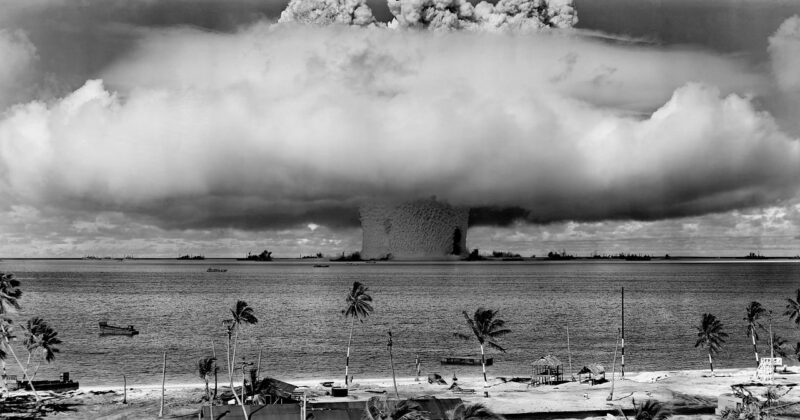The History of Nuclear Weapons: Their Role in Deterrence and Global Diplomacy
November 16, 2024

Nuclear weapons represent one of humanity’s most devastating inventions, engineered initially for warfare; yet their existence has shaped global politics, national defense strategies, and international relations. As humanity grappled with the consequences of their use, particularly in Hiroshima and Nagasaki, nuclear weapons transformed from military tools into instruments of deterrence and diplomacy. In this article, we will journey through the history of nuclear weapons, exploring their development, implications, and the complex role they play in deterring conflicts and shaping global diplomacy.
1. The Dawn of the Nuclear Age
The story of nuclear weapons begins in the early 20th century with groundbreaking discoveries in physics. The Manhattan Project, a top-secret U.S. initiative during World War II, culminated in the first successful test of a nuclear bomb on July 16, 1945, known as the Trinity Test in New Mexico. Shortly after this triumph, the United States dropped atomic bombs on Hiroshima and Nagasaki in August 1945, resulting in unparalleled devastation and loss of life and ushering in not only the end of World War II but also the beginning of the nuclear age.
The impact of these bombings left deep psychological scars and raised ethical questions about humanity’s ability to wield such power.
2. The Cold War Era: A New Paradigm of Deterrence
In the following decades, the world entered the Cold War, marked by a tense rivalry between the United States and the Soviet Union. Both nations expanded their nuclear arsenals, leading to an arms race driven by the doctrine of Mutual Assured Destruction (MAD). This policy implied that a nuclear attack by one superpower would result in full-scale retaliation, leading to the annihilation of both countries.
2.1 The Arms Race
With each side striving to maintain a strategic advantage, the nuclear arsenals grew exponentially. Nuclear tests became a display of power, with events such as the Soviet Union’s detonation of the Tsar Bomba in 1961, the most powerful nuclear weapon ever tested, demonstrating their willingness to engage in this dangerous competition.
2.2 Treaties and Diplomatic Efforts
Amid escalating tensions, a number of treaties emerged as attempts to regulate and reduce the threat of nuclear weapons. The Nuclear Non-Proliferation Treaty (NPT), established in 1968, was a landmark agreement aimed at preventing the spread of nuclear weapons and promoting peaceful uses of nuclear energy. It allowed nuclear-armed states to maintain their arsenals while pushing non-nuclear-armed states to forgo developing such capabilities.
3. Nuclear Weapons and Global Diplomacy
Nuclear weapons have profoundly influenced international relations and diplomatic strategies. Their very existence creates a delicate balance, wherein the threat of potential devastation may prevent conflict.
3.1 The Role of Nuclear Weapons in Diplomacy
– **Deterrence as a Foreign Policy Tool**: Countries with nuclear capabilities often employ their arsenal as a deterrent, ensuring their sovereignty and dissuading adversaries from military action. For instance, nations like North Korea view their nuclear capabilities as essential for regime survival and leverage in international negotiations.
– **Bargaining Chips**: Nuclear weapons have also served as bargaining chips in diplomatic negotiations. During arms control discussions, nuclear-armed states have had to navigate the intricate landscape of power politics, willingly sacrificing certain capabilities in hopes of international recognition or strategic gains.
3.2 Non-Proliferation Efforts
The fear of nuclear proliferation has led to ongoing international policies and treaties aimed at preventing the spread of these weapons. Countries like Iran have found themselves at the center of diplomatic discussions regarding their nuclear ambitions, with ongoing tensions leading to sanctions and complex negotiations over their nuclear program.
4. Contemporary Issues and the Future of Nuclear Weapons
The nuclear landscape continues to evolve. Emerging threats stemming from rogue states, cyber warfare, and terrorism raise pivotal questions about the misuse of nuclear technology and the efficacy of existing treaties.
4.1 Modernization of Nuclear Arsenals
Countries like the U.S. and Russia have invested in modernizing their nuclear capabilities. Technological advancements allow for more precise delivery systems and more potent warheads, igniting debates about the necessity of maintaining such systems.
4.2 The Role of International Organizations
Organizations like the United Nations and the International Atomic Energy Agency (IAEA) play critical roles in overseeing nuclear activities and promoting disarmament. However, achieving substantial progress remains challenging due to political complexities and differing national interests.
5. Ethical Considerations and Humanitarian Impact
The use of nuclear weapons raises profound ethical questions about humanity’s right to possess such destructive power. The humanitarian consequences of their use have led to an evolving discourse around disarmament.
5.1 The Humanitarian Impact of Nuclear Warfare
The bombings of Hiroshima and Nagasaki serve as reminders of the catastrophic human cost of nuclear warfare. Scholars and activists have called for a reevaluation of nuclear policies, emphasizing a humanitarian approach to security that prioritizes stability and reconciliation over deterrence.
Conclusion
The history of nuclear weapons is a potent narrative of invention, strategy, and diplomacy. Their existence has dictated the course of global events since their inception, shaping the landscape of international relations. As we move forward, navigating the challenges of nuclear proliferation and modernization requires not only rigorous diplomacy but also a collective commitment to ethical considerations and humanitarian values. In acknowledging the dual nature of nuclear weapons — as instruments of deterrence and tools of destruction — we must strive for a world in which security is achieved without reliance on these formidable arsenals.








